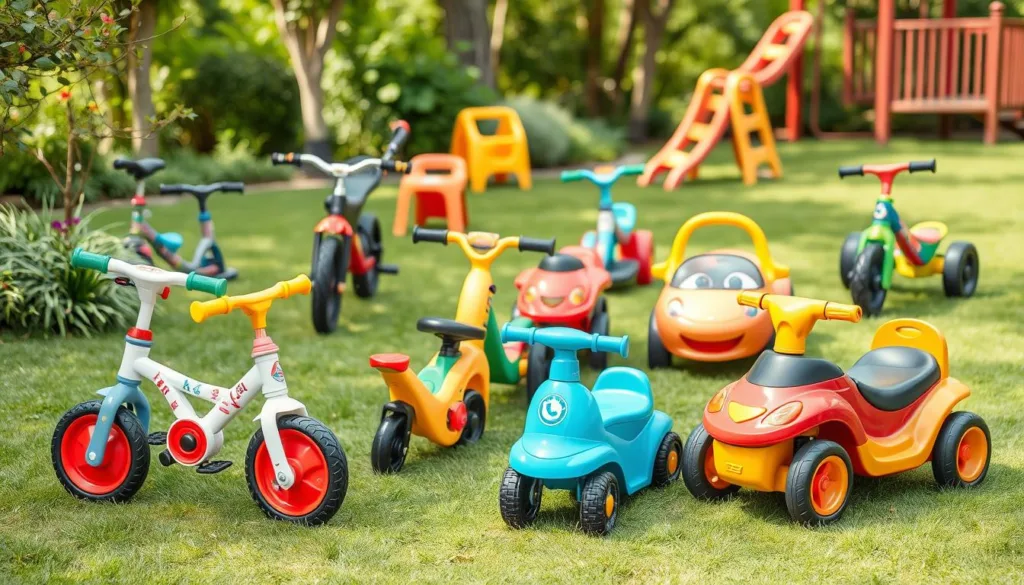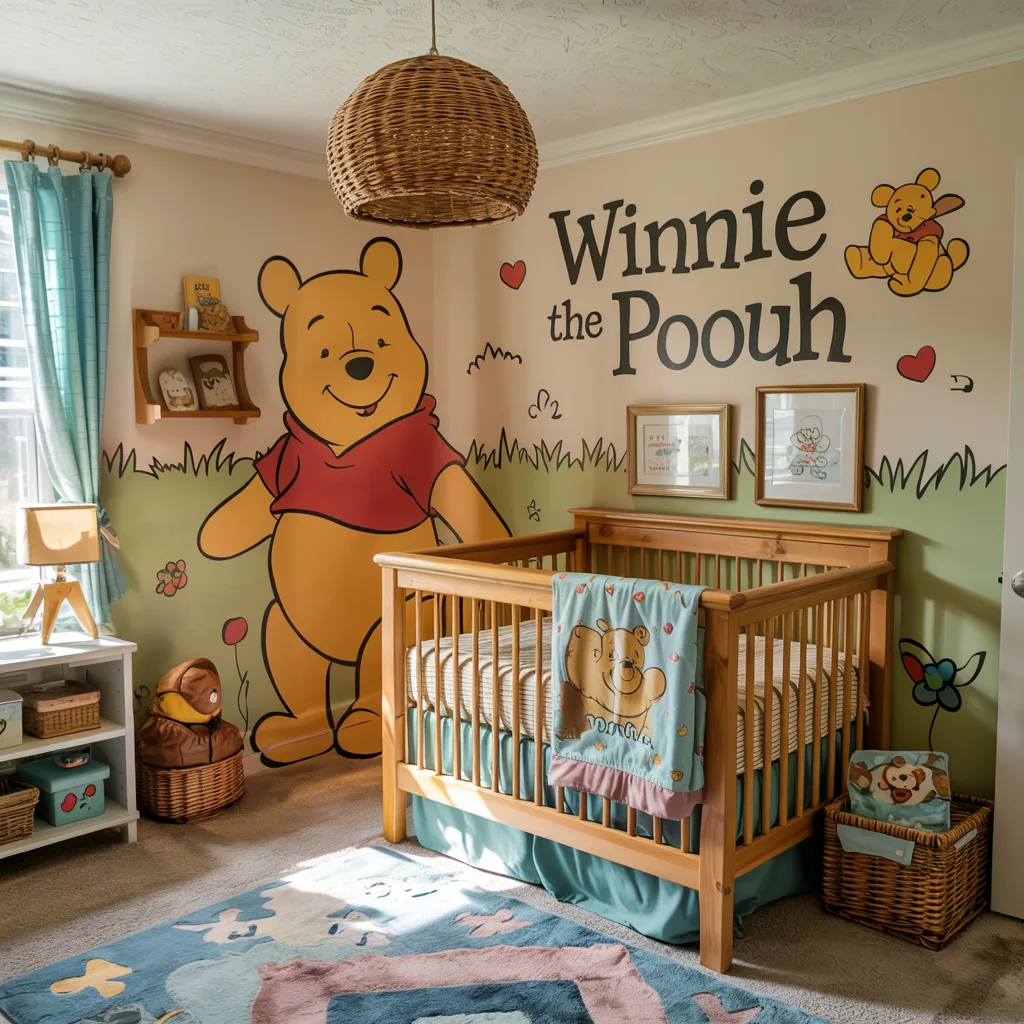Exploring ride-on toys for toddlers can make playtime exciting and educational. These toys help improve your child’s motor skills and keep them entertained. They range from simple push cars to fun battery-powered ones.
Choosing the right ride-on toy is important. You need to think about your toddler’s age, physical abilities, and how they’re growing. The best toy will help with coordination, confidence, and imagination, all while keeping them safe.
Knowing about different ride-on toys helps parents pick the best ones. Each toy offers a chance for your toddler to learn and grow through play. It’s a great way to make playtime both fun and educational.
Key Takeaways
- Ride-on toys support critical physical and cognitive development
- Safety features are crucial when selecting toddler vehicles
- Age-appropriate toys maximize learning and enjoyment
- Outdoor play enhances motor skill development
- Interactive features can boost cognitive engagement
- Regular maintenance ensures long-term toy safety
- Choose toys that grow with your child’s abilities
Table of Contents
Understanding Different Types of Ride-On Toys
Ride-on toys are great for toddlers. They let kids explore and build important motor skills. Each type of ride-on has its own benefits for young learners.

Parents have three main choices of ride-on toys. Each is made for different ages and interests:
Manual Push Toys
Push cars are for the first ride-on experiences of toddlers. They help kids learn to walk and get better at moving. Push cars are for the youngest toddlers.
They let kids:
- Practice walking stability
- Improve gross motor skills
- Explore movement independently
- Build confidence in mobility
Pedal-Powered Vehicles
Tricycles and pedal-powered ride-ons are for preschoolers. They help kids get better at balance and muscle strength. These vehicles challenge kids to:
- Develop leg muscle coordination
- Learn pedaling techniques
- Understand directional control
- Improve overall physical fitness
Battery-Operated Ride-Ons
Electric ride-ons are for older toddlers and kids. They have cool designs and speed controls. These toys offer:
- Exciting driving experiences
- Enhanced sensory engagement
- Introduction to cause-and-effect learning
- Imaginative play opportunities
| Toy Type | Age Range | Key Development Benefits |
|---|---|---|
| Push Cars | 12-24 months | Walking stability, initial coordination |
| Tricycles | 2-4 years | Balance, muscle strength, pedaling skills |
| Electric Ride-Ons | 3-6 years | Spatial awareness, motor control |
“Choosing the right ride-on toy can transform playtime into a powerful learning experience for your child.” – Childhood Development Experts
Knowing about these ride-on toys helps parents pick the best ones. This ensures their child learns and has fun.
Essential Safety Features for Toddler Ride-On Toys
When picking ride-on toys for your toddler, safety comes first. The right design can stop accidents and keep your child safe while playing. A wide base is key for staying stable and avoiding tips, especially for young kids who are still learning balance.

- Safety belts that securely hold your child in place
- Low center of gravity to enhance stability
- Speed limiters to control maximum velocity
- Parental controls for remote monitoring
Electric ride-on toys need extra safety checks. Look for models with:
- Secure battery enclosures
- Clear charge indicators
- Automatic shut-off mechanisms
“Safety isn’t expensive, it’s priceless” – Unknown
Here are some safety tips for ride-on toys:
| Safety Feature | Importance |
|---|---|
| Stable Base | Prevents accidental tipping |
| Speed Control | Reduces risk of high-speed accidents |
| Protective Gear Compatibility | Allows use of helmets and padding |
Always watch your child while they play and check the toy for damage often. A toy with strong safety features means peace of mind and lots of fun for your little one.
Age-Appropriate Selection Guide
Choosing the right ride-on toy is key for your child’s growth. Each age needs toys that fit their skills and strength.

Knowing what toys are right helps parents pick safe and helpful playthings.
12-24 Months Ride-On Options
For little ones, safety and stability are most important. Look for:
- Push cars with wide bases
- Foot-to-floor models with easy-to-grip handles
- Low-profile designs preventing accidental tipping
2-3 Years Recommendations
As toddlers get better at moving, they can handle more toys:
- Tricycles with supportive designs
- Balance bikes for motor skill development
- Ride-on toys with simple steering mechanisms
3-4 Years Choices
Preschoolers need toys that challenge and engage them:
- Pedal-powered go-karts
- Low-speed electric vehicles
- Ride-on toys with interactive features
Safety is always the first thing to think about when picking ride-on toys.
| Age Group | Recommended Toy Types | Skill Development Focus |
|---|---|---|
| 12-24 Months | Push Cars, Foot-to-Floor Models | Balance, Stability |
| 2-3 Years | Tricycles, Balance Bikes | Coordination, Steering |
| 3-4 Years | Pedal Go-Karts, Electric Vehicles | Motor Skills, Independence |
Always watch your child and make sure the toy fits their age and abilities.
Benefits of Ride On Toys for Child Development

Ride-on toys are more than just fun. They help kids grow in many ways. They support physical, cognitive, social, and imaginative development.
Physical benefits are huge. Kids get stronger, balance better, and move more smoothly. Every ride helps build skills for sports and other activities.
“Play is the highest form of research” – Albert Einstein
Cognitive growth happens through play. Kids solve problems, learn about space, and think strategically. These skills are key for the future.
- Navigating obstacles
- Making quick decisions
- Understanding spatial awareness
- Developing strategic thinking
Social skills grow too. Sharing and taking turns teach kids to communicate, cooperate, and solve conflicts. These are important life skills.
- Communication
- Cooperation
- Empathy
- Conflict resolution
Imaginative play is also enhanced. Ride-on toys become magical vehicles. Kids can be firefighters, race car drivers, or space explorers. This boosts creativity and emotional smarts.
Choosing the right ride-on toys and watching over them is key. They provide a great way for kids to grow and have fun.
Popular Ride On Toys for Toddlers
Choosing the right ride-on toy can make playtime exciting for your toddler. There are many options, from classic push-along toys to battery-powered cars. These toys offer fun and learning for toddlers.
Classic Push Cars: Timeless Toddler Favorites
Push-along toys are a big hit with toddlers. The Scuttlebug Bumblebee Ride On is a great choice for young explorers. It has:
- Age range: 1+ years
- Compact dimensions: H43, W33, D60cm
- Maximum weight capacity: 20kg
- Affordable price point of £22 on Argos
Modern Electric Vehicles: Battery-Powered Cars for Young Drivers
Battery-powered cars have changed ride-on toys, making them more interactive. The Mini Vespa Scooter 6V Electric Ride On is a safe and fun choice at £64.99.
| Ride-On Model | Price | Age Range | Weight Capacity |
|---|---|---|---|
| XIAPIA Toddler Tricycle | £41.99 | 10-36 months | 40kg |
| VTech Rock and Ride Unicorn | £46.99 | 18-36 months | Not specified |
| Mini Vespa Scooter 6V | £64.99 | 1-3 years | Varies by model |
Interactive Learning Rides: Educational Ride-Ons
Educational ride-ons mix movement with learning, perfect for growing minds. The VTech Rock and Ride Unicorn is a great example, with interactive features that engage young minds.
“Ride-on toys are not just about fun – they’re about developing motor skills, confidence, and imagination!” – Child Development Specialist
When picking ride-on toys, think about your child’s age, interests, and developmental stage. Whether it’s classic push-along toys or modern battery-powered cars, the right one can bring joy and learning to your toddler.
Maintenance and Care Tips
Keeping your child’s ride-on toy in top shape is key. Regular care ensures safety and keeps the toy working well for longer.
Cleaning the toy is vital. After each play, especially outside, use a damp cloth and mild soap. Make sure to clean off dirt, mud, and debris that could harm the toy’s parts.
Essential Maintenance Checklist
- Do weekly safety checks for loose parts or wear
- Check tires for the right air pressure and wear
- Clean battery connections for electric models
- Lubricate moving parts now and then
- Look over frames and handles for damage
Electric ride-on toys need special battery care. Here’s what to do:
- Charge batteries fully before the first use
- Don’t let the battery drain completely
- Keep it charged at about 50% when not in use for a while
- Swap out batteries when they start to lose power
“Proper maintenance turns a simple toy into a lasting play friend for your child.”
Store your ride-on toys in a clean, dry place to stop rust and damage. For outdoor toys, use a waterproof cover to shield against the weather. These care tips will help your toy last longer and keep your child safe and happy.
Indoor vs Outdoor Ride On Toys
Choosing the right ride-on toy means knowing the difference between indoor and outdoor play. Versatile ride-ons fit both spaces, making playtime safe and fun for your toddler.
Weather-Resistant Features
All-weather toys can handle different weather conditions. Look for ride-ons with:
- UV-resistant materials
- Rust-proof components
- Durable plastic or rubber construction
- Sealed electrical systems for battery-operated models
Space Requirements
The size of your indoor and outdoor areas matters. Small ride-ons are great for tight spaces, while bigger ones are better for open areas.
- Indoor toys: Smaller, quiet, with non-marking wheels
- Outdoor toys: Larger, more robust, designed for different terrains
Surface Considerations
Outdoor safety depends on the ride-on’s surface compatibility. Smooth wheels are best for pavement, while rugged treads handle grass and rough terrain.
Choose a ride-on toy that matches your child’s play environment and developmental stage.
Think about your space, your toddler’s skills, and the toy’s features. This will help ensure a safe and fun ride.
Choosing the Right Size and Design
Choosing the right ride-on toy is important. It needs to be comfortable, safe, and fun for your child. Look for toys that grow with your child, fitting their changing size.
When you’re shopping, keep these things in mind:
- Adjustable features that fit your child’s growth
- Seat height and width for comfort
- Controls that are easy for your child to use
- Sturdy construction for safe play
*”The right ride-on toy grows with your child, making it an investment in fun and development.”*
Parents should look for toys that can change with their child. Many parents want safety features like seat belts. They also like toys with controls that parents can use.
It’s also important to find toys that fit different body types. Look for wide seats, backrests, and handles that are easy to hold.
The material of the toy is also key. Better materials mean the toy lasts longer. Look for toys that are:
- Modular for easy changes
- Comfortable to sit in
- Light but strong
- Right for your child’s age
Need help finding the right toy? Call CarePlay at 330-722-5033. They can help you find a toy that fits your child’s needs and stage of growth.
Storage Solutions and Organization
Keeping your child’s ride-on toys organized can be tough. But, with smart strategies, you can make a clutter-free space. Using space-saving storage helps keep your home tidy and your child’s toys in good shape.
Garage Storage Options
Turn your garage into a neat storage area for ride-on toys. Here are some smart storage ideas:
- Wall-mounted racks to use vertical space well
- Ceiling hoists for storing things up high
- Weatherproof covers to keep toys dust-free and dry
Indoor Storage Ideas
Indoor spaces can also be organized with multi-functional furniture. Look for:
- Storage ottomans with secret spots
- Under-bed containers for extra storage
- Cube shelving with bins you can take out
Protection from Elements
Keeping your ride-on toys safe means protecting them well. Use weatherproof covers outside and pick storage spots that keep toys away from too much heat or moisture.
| Storage Solution | Price Range | Best For |
|---|---|---|
| Ikea Kallax Shelf Unit | $45-$80 | Indoor toy storage |
| KOUSI Large Cube Storage | From $50 | Modular toy organization |
| Mustard Made Locker | $329 | Stylish, durable storage |
“A place for everything, and everything in its place” – Benjamin Franklin
Give your child a special spot for their ride-on toys to teach them about organization. Regular cleaning and proper storage will make these toys last longer. It also keeps your home safe and neat.
Conclusion
Choosing the right ride-on toys is key to making playtime a learning experience. It’s not just about avoiding accidents. It’s about giving your child chances to grow and learn.
Safe toys, like ride-on vehicles, do more than entertain. They help improve motor skills, balance, and encourage being active. By picking toys that fit your child’s age and are safe, you help them learn and grow.
Ride-on toys are an investment in your child’s future. They help with independence, problem-solving, and understanding space. The right toys boost confidence and curiosity, making playtime both fun and safe.
The best toys are those that match your child’s age, spark their creativity, and are safe. By focusing on safety, adaptability, and fun design, you make playtime truly valuable.
FAQ
What age groups are ride-on toys suitable for?
Ride-on toys fit different ages, from 12 months to 4 years. For 12-24 months, simple push cars are best. Toddlers aged 2-3 do well with tricycles and balance bikes.
Children aged 3-4 can enjoy more complex toys. Always check the age and weight limits for safety.
Are battery-operated ride-on toys safe for toddlers?
When chosen wisely, battery-operated toys can be safe. Look for models with safety features like speed controls and secure batteries. Always supervise young children and follow the manufacturer’s guidelines.
How do ride-on toys contribute to child development?
Ride-on toys help in many ways. They improve physical skills like balance and coordination. They also help with gross motor skills and spatial awareness.
These toys encourage problem-solving and social skills. They boost creativity and confidence too.
What safety features should I look for in a ride-on toy?
Look for a stable design and effective brakes. Safety belts or harnesses are important. Speed controls and bright colors for visibility are also key.
Check for sturdy construction and age-appropriate design. Make sure it matches your child’s abilities.
Can ride-on toys be used both indoors and outdoors?
Some toys are good for both indoors and outdoors. Outdoor models are weather-resistant and durable. Indoor toys are smaller with non-marking wheels.
Consider your space and the toy’s design when choosing.
How often should I maintain my child’s ride-on toy?
Regular maintenance is key for safety and longevity. Check tire pressure, brakes, and structure regularly. Clean the toy after each use, especially after outdoor play.
For battery-operated models, follow charging and storage guidelines. Inspect for wear and tear often and fix any issues quickly.
What type of ride-on toy is best for a first-time user?
For first-timers, younger toddlers, manual push cars or foot-to-floor models are best. They are stable and help develop walking skills. Look for models with easy-to-grip handles and a low center of gravity.
How do I store ride-on toys effectively?
Use wall-mounted racks, ceiling hoists, or multi-functional furniture for storage. Use weatherproof covers for outdoor storage. Designate a specific spot for each toy to teach organization.
Ensure the storage area is clean, dry, and protects the toy from damage.











